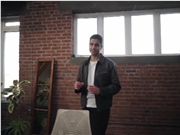In the wave of AI-driven creativity, a breakthrough technology is quietly transforming the landscape of 3D graphics design. The newly released VideoFrom3D framework cleverly integrates image and video diffusion models, generating highly realistic and stylistically consistent 3D scene videos from rough geometries, camera paths, and reference images. This innovation eliminates the need for expensive paired 3D datasets, greatly simplifying the design process and allowing designers and developers to explore creativity more efficiently and produce high-quality results quickly.

Framework Core: Innovative Fusion of Complementary Diffusion Models
The core of VideoFrom3D lies in its dual-module architecture: the Sparse Anchor View Generation (SAG) module and the Geometry-Guided Generative Interpolation (GGI) module. The SAG module uses an image diffusion model to generate high-quality cross-view consistent anchor views based on a reference image and rough geometry, ensuring visual detail and stylistic consistency. Subsequently, the GGI module leverages a video diffusion model to interpolate intermediate frames based on the anchor views, achieving smooth motion and temporal consistency through flow-based camera control and structural guidance.
This design skillfully avoids the pain points of traditional video diffusion models in complex scenes—such as the joint challenges of visual quality, motion modeling, and temporal consistency. Research shows that this framework can produce high-fidelity videos without any 3D-natural image paired data, significantly improving generation efficiency.
Technical Highlights: Zero-Barrier Revolution Without Datasets
Different from previous 3D generation methods that rely on massive annotated data, the "zero-paired" strategy of VideoFrom3D is its biggest highlight. It only needs to input rough geometry (such as simple meshes or point clouds), a camera path, and a reference image to automatically synthesize a complete video sequence. This not only lowers the barrier to data acquisition but also supports style variations and multi-view consistency, making it suitable for diverse applications ranging from indoor scenes to outdoor landscapes.
Experimental results show that VideoFrom3D outperforms existing baseline models in benchmark tests, especially excelling in complex dynamic scenes. The fidelity of generated videos reaches professional-grade levels, with natural and smooth motion and highly consistent styles, injecting "plug-and-play" vitality into 3D graphics design.
Application Prospects: Accelerating 3D Design and Content Creation
The release of this framework will profoundly impact the fields of 3D graphics design, film special effects, and virtual reality. Designers can quickly iterate from sketches to finished video products, shortening production cycles; developers can easily build immersive scenes for game prototypes or AR experiences. More importantly, it promotes the democratization of AI in creative tools, enabling small and medium teams to access advanced generation capabilities.
Conclusion: A New Paradigm in Design for the AI Era
VideoFrom3D is not just a technical framework, but a turning point in the paradigm of 3D content generation. It demonstrates the infinite potential of diffusion models in the 3D field and foreshadows more "from zero to one" innovations in the future.










